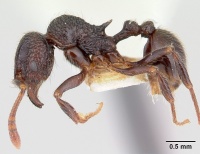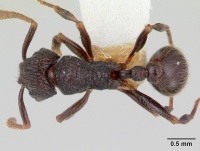Cyphoidris
| Cyphoidris | |
|---|---|

| |
| Cyphoidris spinosa | |
| Scientific classification | |
| Kingdom: | Animalia |
| Phylum: | Arthropoda |
| Class: | Insecta |
| Order: | Hymenoptera |
| Family: | Formicidae |
| Subfamily: | Myrmicinae |
| Tribe: | Crematogastrini |
| Alliance: | Carebara genus group |
| Genus: | Cyphoidris Weber, 1952 |
| Type species | |
| Cyphoidris spinosa | |
| Diversity | |
| 4 species (Species Checklist, Species by Country) | |
Of the known species of Cyphoidris, Cyphoidris exalta and Cyphoidris spinosa are of Central African origin and inhabit the leaf litter layer; Cyphoidris parissa originates in West Africa, and Cyphoidris werneri is the only known East African representative of the genus. All of these species have been found in the leaf litter but details about their biology are not known.
Identification
An easily defined genus, Cyphoidris is the only African representative of a group of genera centring on Lordomyrma, most of which have an Indo-Australian or Neotropic distribution. Cyphoidris is close to Lordomyrma itself but differs as the latter has 12-segmented antennae, a reduced palpomere count, and has the propodeal spiracle set well forward from the margin of the declivity. (Bolton 1981)
| See images of species within this genus |
Keys to Species in this Genus
Distribution
Distribution and Richness based on AntMaps
Species by Region
Number of species within biogeographic regions, along with the total number of species for each region.
| Afrotropical Region | Australasian Region | Indo-Australian Region | Malagasy Region | Nearctic Region | Neotropical Region | Oriental Region | Palaearctic Region | |
|---|---|---|---|---|---|---|---|---|
| Species | 5 | 0 | 0 | 0 | 0 | 0 | 0 | 0 |
| Total Species | 2851 | 1736 | 3047 | 932 | 840 | 4391 | 1767 | 2925 |
Biology
Life History Traits
- Mean colony size: ? (Greer et al., 2021)
- Compound colony type: not parasitic (Greer et al., 2021)
- Nest site: hypogaeic (Greer et al., 2021)
- Diet class: ? (Greer et al., 2021)
- Foraging stratum: subterranean/leaf litter (Greer et al., 2021)
Castes
Morphology
Worker Morphology
 Explore: Show all Worker Morphology data or Search these data. See also a list of all data tables or learn how data is managed.
Explore: Show all Worker Morphology data or Search these data. See also a list of all data tables or learn how data is managed.
• Antennal segment count: 11 • Antennal club: 3 • Palp formula: 4,3 • Total dental count: 9-12 • Spur formula: 0,0 • Eyes: 11-100 ommatidia • Pronotal Spines: absent • Mesonotal Spines: absent • Propodeal Spines: present • Petiolar Spines: absent • Caste: none or weak • Sting: present • Metaplural Gland: present • Cocoon: absent
Male Morphology
 Explore: Show all Male Morphology data or Search these data. See also a list of all data tables or learn how data is managed.
Explore: Show all Male Morphology data or Search these data. See also a list of all data tables or learn how data is managed.
• Antennal segment count 10 • Antennal club 0 • Palp formula 4,3 • Total dental count 7 • Spur formula 0, 0
Phylogeny
| Myrmicinae |
| ||||||||||||||||||||||||||||||||||||||||||||||||||||||||||||||||||||||||||||||||||||||||||||||||||||||||||||||||||||||||||||||||||||||||||||||||||||||||||||||||||||||||||||||||||||||||||||||||||||||||||||||||||||||||||||||||||||||||||||||||||||||||||||||||||||||||||||||||||||||||||||||||||||||||||||||||||||||||||||||||||||||||||||||||||||||||||||||||||||||||||||||||||||||||||||||||||||||||||||||||||||||||||||||||||||||||||||||||||||||||||||||||||||||||||||||||||||||||||||||||||||||||||||||||||||||||||||||||||||||||||||||||||||||||||||||||||||||||||||||||||||||||||||||||||||||||||||||||||||||||||||||||||||||||||||||||||||||||||||||||||||||||||||||||||||||||||||||||||||||||||||||||||||||||||||||||||||||||||||||||||||||||||||||||||||||||||||||||||||||||||||||||||||||||||||||||||||||||||||||||||||||||||||||||||||||||||||||||||||||||||||||||||||||||||||||||||||||||||||||||||||||||||||||||||||
See Phylogeny of Myrmicinae for details.
Nomenclature
The following information is derived from Barry Bolton's Online Catalogue of the Ants of the World.
- CYPHOIDRIS [Myrmicinae: Stenammini]
- Cyphoidris Weber, 1952: 26. Type-species: Cyphoidris spinosa, by original designation.
- CYPHOMANNIA [junior synonym of Cyphomyrmex]
- Cyphomannia Weber, 1938b: 183 [as subgenus of Cyphomyrmex]. Type-species: Cyphomyrmex (Cyphomannia) laevigatus, by original designation.
- Cyphomannia subgenus of Cyphomyrmex: Weber, 1938b: 183; Weber, 1966: 166.
- Cyphomannia junior synonym of Cyphomyrmex: Kempf, 1962b: 29; Kempf, 1972a: 92.
Worker
Bolton (1981) - Monomorphic myrmicine ants. Mandibles triangular with an elongate apical (masticatory) margin bearing 10-14 small teeth or denticles which decrease in size from apex to base. Palp formula 4, 3. Median portion of clypeus narrow and raised, bicarinate above and narrowly inserted between the frontal lobes. Lateral portions of clypeus unmodified, not forming a shield-wall or raised ridge in front of the antennal insertions. Frontal lobes not strongly expanded but covering the antennal insertions, prolonged posteriorly as a pair of strongly developed frontal carinae which form the dorsal margins of a pair of strong and conspicuous broad scrobes; the scrobes run back almost to the occiput. Ventral margin of scrobe a longitudinal ridge or ruga running above the eye, the latter of moderate size and situated in front of the midlength of the sides. Antennae II-segmented, with a conspicuous 3-segmented club apically. Alitrunk in profile with promesonotum fused and swollen, the dorsum dome-like and strongly convex in outline, much elevated above the level of the propodeum. Propodeum bispinose; the spiracle close to the margin of the declivity, the orifice circular and directed posteriorly. Metapleural lobes low and triangular. Petiole with an elongate anterior peduncle and well developed node. Sting terminating in a narrow spatulate appendage apically.
References
- Blaimer, B.B., Ward, P.S., Schultz, T.R., Fisher, B.L., Brady, S.G. 2018. Paleotropical diversification dominates the evolution of the hyperdiverse ant tribe Crematogastrini (Hymenoptera: Formicidae). Insect Systematics and Diversity 2(5): 3; 1-14 (doi:10.1093/isd/ixy013).
- Brown, W. L., Jr. 1973b. A comparison of the Hylean and Congo-West African rain forest ant faunas. Pp. 161-185 in: Meggers, B. J., Ayensu, E. S., Duckworth, W. D. (eds.) Tropical forest ecosystems in Africa and South America: a comparative review. Wash (page 179, Cyphoidris as junior synonym of Lordomyrma [provisional])
- Cantone S. 2018. Winged Ants, The queen. Dichotomous key to genera of winged female ants in the World. The Wings of Ants: morphological and systematic relationships (self-published).
- Greer, J. A., Moreau, C. S. 2021. Phylogenetic analysis and trait evolution of ant cocoons. Insect Systematics & Evolution 53(1), 60–77 (doi:10.1163/1876312x-bja10008).
- Kugler, C. 1997. Stings of some species of Lordomyrma and Mayriella (Formicidae: Myrmicinae). Insecta Mundi 11, 193-199.
- Bolton, B. 1981. A revision of six minor genera of Myrmicinae (Hymenoptera: Formicidae) in the Ethiopian zoogeographical region. Bulletin of the British Museum (Natural History) Entomology. 43:245-307. PDF (page 257, Cyphoidris valid genus, and revision of genus)
- Weber, N. A. 1952a. Studies on African Myrmicinae, I (Hymenoptera, Formicidae). American Museum Novitates 1548: 1-32 (page 26, Cyphoidris as genus)

